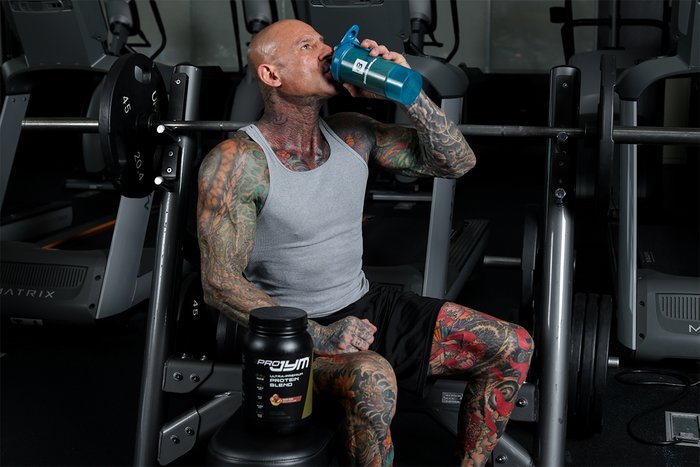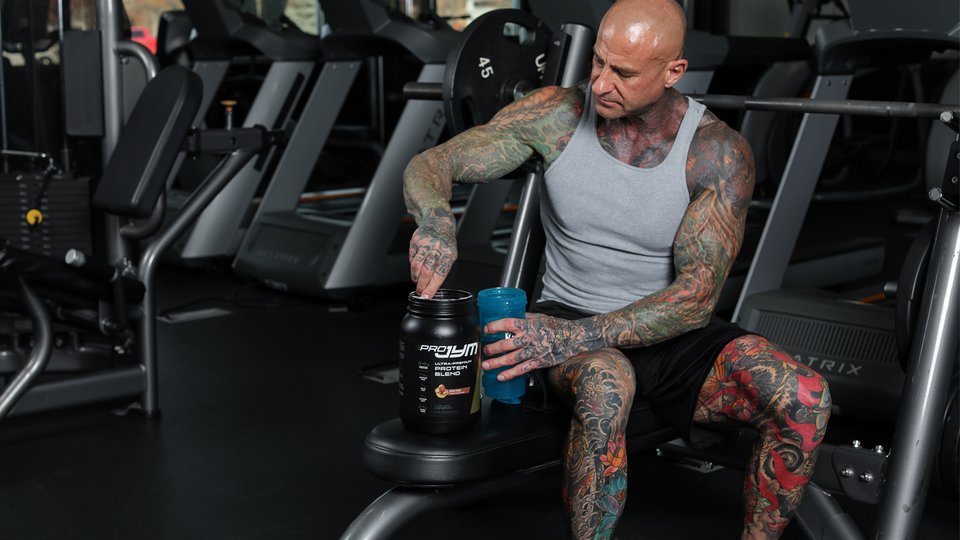Products You May Like
You put a lot of time and hard work into the gym to build serious muscle, so the last thing you want is for those gains to be blurred by body fat. Big chest, back, shoulders, legs, and arms, with a big gut to match, isn’t most people’s physique goal.
Yet gaining lean muscle without adding excess body fat can be a challenge. In addition to being consistent with a well-designed training program (like Shortcut to Shred or Super Shredded 8), following a smart diet plan (such as the Shortcut to Shred diet) with ample protein, healthy fats, and proper carbohydrate intake is paramount.
Then there’s the third element of building a bigger, stronger, leaner physique: supplements. Combine the right products, and you’ll get a synergy of ingredients that will help make losing body fat while gaining muscle mass much less of a challenge.
For this specific purpose, my preferred JYM supplement stack calls on three products: Pro JYM, a high-quality protein powder blend; Shred JYM, my popular fat burner; and Omega JYM, my super-potent fish oil.
Take these three products in conjunction with proper training and nutrition, and all your hard work in the gym will start translating to more shredded muscle, not just sheer size. Here’s a rundown of all three products and how they work to build muscle and shed fat.
1. Pro JYM
Pro JYM is included because higher protein intake is needed for maximizing muscle growth. After all, the right blend of fast- and slow-digesting proteins, as you’ll find in Pro JYM, optimizes the anabolic environment in muscle cells.

Yet while the extra protein is good for boosting muscle growth, it also can aid fat loss.* Research shows that high-protein diets can spur greater fat loss than higher-carb-based diets.
This may be due to two main reasons: the higher boost in metabolism that higher-protein meals cause, and the fact that higher protein intake can spur greater muscle protein synthesis, which is a calorie-burning process.* In other words, you burn more body fat as you build more muscle.
One of the most compelling cases in favor of a high-protein diet for losing body fat came from a 2016 study published in the Journal of the International Society of Sports Nutrition. In the study, subjects consuming 1.5 grams of protein per pound of body weight per day lost an average of 5 pounds more body fat over an eight-week period than those consuming 1 gram per pound, despite taking in an additional 500 calories per day![1]
2. Shred JYM
Another shoo-in for this stack is my highly effective fat burner Shred JYM. What’s nice about Shred JYM is it uses tried-and-true ingredients like caffeine, green tea, capsaicin, carnitine, synephrine, and tyrosine at proper doses to boost fat loss effectively—and safely.
Here’s a description of each of the five main Shred JYM ingredients:
Caffeine is known to boost calorie burning, but it also contributes to fat loss by helping to release more fat from the fat cells and prevent fat storage in the fat cells.[2]*
Green tea (Camellia sinensis) contains compounds called catechins, including epigallocatechin gallate (EGCG), the main catechin responsible for the thermogenic effect of green tea. Its major thermogenic effect comes from the ability of EGCG to inhibit an enzyme that normally breaks down norepinephrine, the neurotransmitter involved in regulating metabolic rate and fat-burning.*
By inhibiting the enzyme, you maintain higher levels of norepinephrine, which encourages greater calorie and fat burn.[3]*
Carnitine plays a critical role in helping transport fat across the mitochondria of cells.* The mitochondria are essentially all cells’ power plants where the majority of ATP (adenosine triphosphate) is derived for energy. Once the fatty acids pass into the mitochondria, they can be oxidized (“burned”) to generate ATP. Without adequate carnitine, most dietary fats cannot get into the mitochondria and be burned for fuel.[4]

Capsaicin is the major pungent substance in red hot peppers, such as cayenne chili peppers. It works to ramp up metabolic activity, which increases the amount of calories and fat your body burns.*
It also reduces hunger and food intake so that you consume fewer calories yet burn more.*
Research confirms that supplementing the diet with capsaicin leads to significant fat loss over time.[5]*
Synephrine is the active ingredient in the plant Citrus aurantium, also known as bitter orange. It stimulates specific receptors that increase the release of fat from fat cells and it increases metabolic rate while also decreasing appetite.*
Several studies confirm that synephrine is both effective for fat loss and is very safe, with no known negative effects.[6]*
Tyrosine, an amino acid, has a proven track record for increasing alertness, mental focus, and energy, especially when combined with caffeine.*
It’s used in the body to produce several important hormones and neurotransmitters such as dopamine, epinephrine (adrenaline), norepinephrine, and thyroid hormones.*
Increased levels of these hormones and neurotransmitters helps make you more alert and focused. This is important when dieting, as lowering your calorie intake can decrease your energy levels, mood, and mental sharpness. Maintaining higher epinephrine, norepinephrine, and thyroid hormones also aids fat loss.[7]*
3. Omega JYM
You may be well aware of the health benefits of the omega-3 fats eicosapentaenoic acid (EPA) and docosahexaenoic acid (DHA). But did you know omega-3s are also important for promoting muscle growth and fat loss?*
A recent study from the National Taiwan University found that the omega-3 fats from fish oil turned on genes that regulate fat burning by the body, while turning off genes that led to fat storage.*
In addition, they found that these fats also turned on genes that aided in glucose uptake and storage by the muscles.[8]*
Other research shows that the right amount (1500 milligrams) of the omega-3 fat DHA increases muscle protein synthesis to promote greater muscle growth.[9]*
Omega JYM is one of the only supplements to provide a full dose of 1500 milligrams per four capsules, along with another 1500 milligrams of EPA and 300 milligrams of the omega-3 docosapentaenoic acid (DPA).
How to Take the JYM Ultimate Fat-Loss Stack
For best results, take the three products daily according to the below guidelines:
Pro JYM
Mix each scoop of Pro JYM in 6-12 ounces of water or milk. Consume 1-2 scoops within 30 minutes before workouts, and 1-2 scoops within 30 minutes after workouts. Also consider taking 1-2 scoops when you first wake up in the morning, before going to bed, and/or between meals.
Shred JYM
Take 1-3 times daily for maximum fat loss. If you have a sensitive stomach (particularly with green tea extract), take Shred JYM with meals. If you’re sensitive to caffeine, don’t take Shred JYM within six hours of bedtime.
Omega JYM
Take four Omega JYM softgels per day, with food. You can either take the four capsules all at once with the meal of your choice or split it up into two doses of two capsules each.
* These statements have not been evaluated by the Food and Drug Administration. This product is not intended to diagnose, treat, cure, or prevent any disease.
Want unlimited access to all of Jim Stoppani’s programs and an endless supply of content like this? Visit JimStoppani.com and become a member.
References
- Antonio, J., Ellerbroek, A., Silver, T., Vargas, L., & Peacock, C. (2016). The effects of a high protein diet on indices of health and body composition–a crossover trial in resistance-trained men. Journal of the International Society of Sports Nutrition, 13(1), 3.
- Acheson, K. J., Zahorska-Markiewicz, B., Pittet, P., Anantharaman, K., & Jéquier, E. (1980). Caffeine and coffee: their influence on metabolic rate and substrate utilization in normal weight and obese individuals. The American Journal of Clinical Nutrition, 33(5), 989-997.
- Ahmed, S., Wang, N., Lalonde, M., Goldberg, V. M., & Haqqi, T. M. (2004). Green tea polyphenol epigallocatechin-3-gallate (EGCG) differentially inhibits interleukin-1β-induced expression of matrix metalloproteinase-1 and-13 in human chondrocytes. Journal of Pharmacology and Experimental Therapeutics, 308(2), 767-773.
- Seim, H., Kiess, W., & Richter, T. (2002). Effects of oral L-carnitine supplementation on in vivo long-chain fatty acid oxidation in healthy adults. Metabolism-Clinical and Experimental, 51(11), 1389-1391.
- Westerterp-Plantenga, M. S., Smeets, A., & Lejeune, M. P. G. (2005). Sensory and gastrointestinal satiety effects of capsaicin on food intake. International Journal of Obesity, 29(6), 682.
- Stohs, S. J., Preuss, H. G., & Shara, M. (2012). A review of the human clinical studies involving Citrus aurantium (bitter orange) extract and its primary protoalkaloid p-synephrine. International Journal of Medical Sciences, 9(7), 527.
- Deijen, J. B., & Orlebeke, J. F. (1994). Effect of tyrosine on cognitive function and blood pressure under stress. Brain Research Bulletin, 33(3), 319-323.
- Yu, Yu-Hsiang, Shinn-Chih Wu, Winston Teng-Kuei Cheng, Harry J. Mersmann, Tang-Long Shen, and Shih-Torng Ding. “The function of porcine PPARγ and dietary fish oil effect on the expression of lipid and glucose metabolism related genes.” The Journal of Nutritional Biochemistry 22, no. 2 (2011): 179-186.
- Smith, G. I., Atherton, P., Reeds, D. N., Mohammed, B. S., Rankin, D., Rennie, M. J., & Mittendorfer, B. (2010). Dietary omega-3 fatty acid supplementation increases the rate of muscle protein synthesis in older adults: a randomized controlled trial. The American Journal of Clinical Nutrition, 93(2), 402-412.
